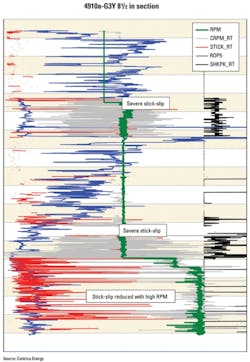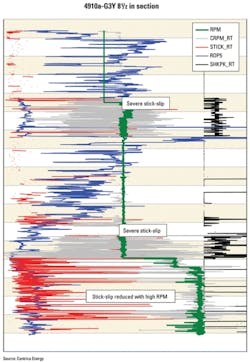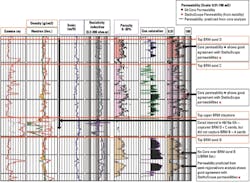Investment in high technology solutions pays dividends
Tim Blasdale
Schlumberger
All hydrocarbon producing regions around the world present particular drilling challenges, but the Southern North Sea (SNS) presents more than most. This area was the location, in 1965, of the first commercial hydrocarbon discovery on the UK continental shelf (UKCS). Gas production began in 1967, and most subsequent production from the SNS has been of gas. The low value of remaining reserves in the mature fields precludes high drilling expenditures, and significant cost reductions are required for economic development of the remaining smaller pockets of gas.
Drilling challenges
A significant proportion of the SNS reservoirs are characterized as tight gas, and to be economically viable, wells need to have long horizontal producing sections that connect productive natural fracture networks. These natural fractures represent one of several challenges to drilling, and underbalanced drilling (UBD) often is required to avoid total loss of drilling fluid.
Southern North Sea overburdens can be highly problematic. Many reservoirs are deep in the Jurassic or Carboniferous, and to get to them, wells have to pass through a number of formation types, unknown pressure regimes, and high shock and vibration environments that can exhibit extreme drilling problems. Variable lithology prevails, including very soft strata, hydrophilic shales, hard stringers, and highly abrasive sand layers. Mobile formations such as halites and evaporites require hole sections to be drilled quickly and cased-off before wellbore quality deteriorates,
Most installations in the SNS are small jackets over a small number of wellheads. The lack of a drilling package on most of the platforms requires a mobile jackup rig to be put in place over the jacket, adding cost compared to drilling from a platform. A further complication is that most support for the SNS is based in Aberdeen, Scotland, requiring a journey each way of about 500 mi (800 km), so replacing failed equipment can incur high rates of non-productive time (NPT).
Advanced drilling solutions
The highly challenging geological conditions in the SNS increase the risk of drilling equipment breakages and the bottomhole assembly (BHA) getting stuck downhole. To reduce this risk and to avoid losing expensive equipment, operators historically have tended to select robust, but relatively low-performing, directional drilling systems such as downhole turbines coupled with basic logging-while-drilling (LWD) or tubing-conveyed logging systems.
Schlumberger is in partnership with several operators to implement a high-technology approach in the SNS that is taking advanced drilling equipment further than was previously considered possible in the area.
Effective operations support
Schlumberger has made large global investments in developing Operation Support Centers (OSCs), an initiative that started in Aberdeen in 2002. The value of OSCs was realized immediately, and the concept was expanded from surveillance and quality assurance function to become an organization where expertise could quickly be accessed and immediately deployed to intervene in offshore operations if required.
The Aberdeen OSC has been a major contributor to improved service quality all over the North Sea, and of particular benefit in areas, such as the SNS, that have specific drilling challenges.
There are three key areas of investment that have enabled the success of OSCs – staff, communications, and the working environment. The facilities have people of the highest caliber, including expert directional drillers and highly experienced LWD engineers to staff the 24/7 surveillance service, plus well placement domain champions, petrophysics domain champions, drilling optimization engineers, as well as drilling and planning engineers.
A robust, secure and yet flexible real time communications system connects OSCs to the field, clients and a global network of expertise.
A custom designed ergonomic working environment is the third key factor that enables OSCs to function to their highest potential. Combined, these three factors have proved successful in enabling problems to be solved quickly, lessons learned to be captured – either in a local knowledge database or the Schlumberger global database – and delivering continuous improvement in the service provided to customers. Schlumberger today operates 50 OSCs worldwide.
Grove field
Centrica Energy operates the Grove field in the SNS, which produces gas from the Leman Sands (Permian) and Barren Red Measures (BRM) sands (Carboniferous) at depths to about 11,000 ft (3,350 m).
During the period July 2008 to May 2009, Schlumberger partnered in the planning, drilling, and evaluation of four appraisal /development wells in the Grove field for Centrica, from the surface and also sidetracks. The first well, drilled using water-based mud, used the PowerDrive X5 RSS in the 12 ¼-in. and 8 ½-in. sections. However, severe stick-slip was experienced, and rpm speeds at the limit of the PowerDrive X5 tools specification were required to mitigate this.
Permeabilities derived from StethoScope measurements correlated well with core data. (Image courtesy of Centrica Energy)
In subsequent wells, the PowerDrive Xceed RSS tool was used, which can comfortably operate at 350 rpm, meaning that the tool was able to operate at the rpm levels required to mitigate against stick slip. The PowerDrive Xceed system therefore gave better directional control, which in turn allowed higher rate of penetration (ROP). The EcoScope multifunction LWD service was provided for all the wells. The StethoScope formation pressure-while-drilling service was used in the 8 ½-in. and 6-in. sections.
The Aberdeen Operation Support Center (OSC) was involved throughout the drilling of the wells to monitor downhole BHA dynamics and to advise on modifications to drilling parameters to reduce the shock and vibrations to the tool. OSC engineers also monitored the MWD and LWD data for quality control and NPT reduction. Reservoir engineers in the OSC supported optimization of formation pressure-while-drilling operations to ensure that its measurements met defined objectives. In total, 41,046 ft (12,511 m) was drilled in 738 on-bottom hours. There were no trips for tool failures. Only 2 hours NPT were incurred during 2,073 hr of rig time.
After the first well suffered formation damage and high skin, the Grove team decided to review the drilling and completion strategy for the next three wells. During the review, the EcoView integrated petrophysical interpretation system was used, along with data from the formation pressure-while-drilling service, to evaluate net to gross, gas saturation, permeabilities, and the position of the gas-water interface.
Porosities and permeabilities derived from measurements were compared with data from cores, and showed excellent correlation. The evaluation determined that the gas-water contact was 130 ft (40 m) deeper than the original interpretation. As a result, the rig was immediately called, where engineers were able to quickly change the completion program to accommodate the deeper intervals, adding extra reserves.
A production estimate was made using Single Well Predictive Modeling and the StethoScope, LWD, and core data. Once the well test results were available, excellent correlation was seen, indicating that LWD data with supportive static and dynamic reservoir including fluid information could be used for early production estimation.
Paying dividends
Several different E&P companies have recognized the value, and are benefitting from, using high-technology drilling solutions in the SNS. For example, Perenco used a similar combination of RSS and LWD equipment as used in the Grove field to drill two wells from the surface to appraise the extent of a different Leman Sand reservoir. The work was performed during February-April 2009.
The well drilled 17,342 ft (5,286 m) in 205 on-bottom hours. Twelve BHA runs were performed, including eight shoe-to-shoe runs. There were no trips for tool failures and zero NPT was incurred during 625 hr of rig time.
In one of the wells, the real-time formation pressure measurements provided by the StethoScope service provided Perenco with the confidence to stop drilling, plug and abandon, saving rig time that would otherwise have been wasted.
Efforts to minimize field developments costs by using low technology drilling technology can be a false economy. Modern reliable and durable state-of-the-art RSS tools can deliver faster ROP and higher quality holes. Development and investment in LWD tools to improve both reliability and capability has improved the effectiveness of well placement and reduce overall rig time while eliminating the need for additional logging runs, and this philosophy has been taken up by eight major clients operating in the SNS in the past two years. The SNS is just one of several hydrocarbon producing areas around the world where, despite challenging economic and geological environments, investment in high technology drilling solutions can lead to reduced overall development cost, increased reserves, and higher production rates.
Offshore Articles Archives
View Oil and Gas Articles on PennEnergy.com





